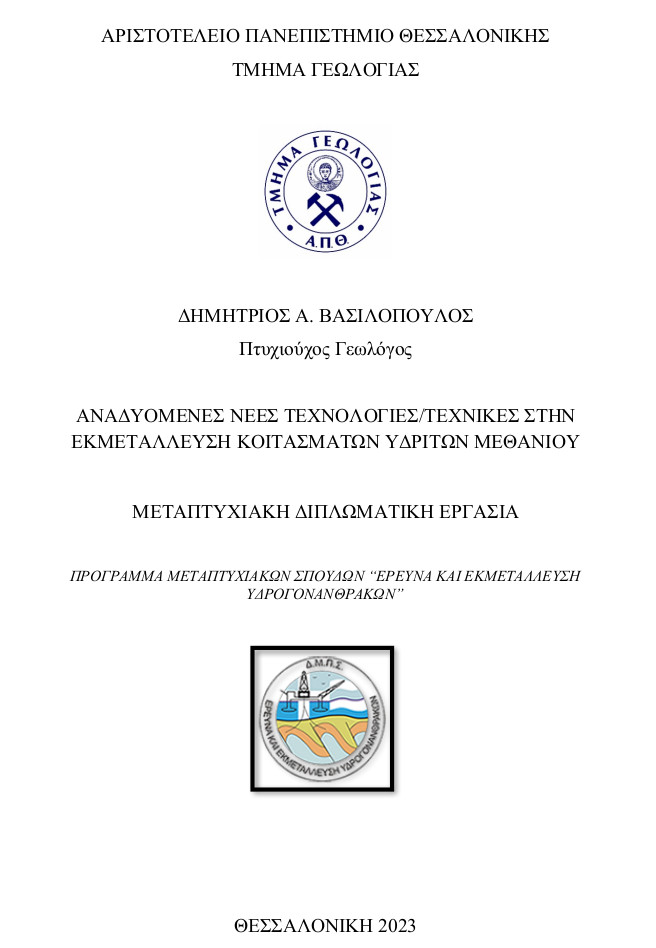
Αναδυόμενες νέες τεχνολογίες/τεχνικές στην εκμετάλλευση κοιτασμάτων υδριτών μεθανίου = Emerging new technologies/techniques in exploitation of gas hydrates deposits.
Περίληψη
Σε αυτή λοιπόν την κατηγορία εντάσσονται και τα κοιτάσματα υδριτών φυσικού αερίου. Τα κοιτάσματα αυτού του τύπου δύναται να συμβάλλουν σε ένα ποσοστό στο παγκόσμιο ενεργειακό μείγμα εφόσον, φυσικά, υπάρξουν και οι κατάλληλες συνθήκες από πλευράς οικονομικής και τεχνικής εφικτότητας. Οι φυσικές συγκεντρώσεις υδριτών φυσικού αερίου με κυρίαρχο συστατικό το μεθάνιο, εκτιμώνται ότι έχουν υψηλότερη ενεργειακή απόδοση από τα υπόλοιπα κοιτάσματα φυσικού αερίου και πετρελαίου. Με δυνατότητα αξιοποίησης μόλις μόνο ενός μικρού μέρους αυτών των κοιτασμάτων, θα μπορούσε να καταστεί δυνατή η κάλυψη της ενεργειακής ζήτησης για αρκετά χρόνια.
Σκοπός της παρούσας μεταπτυχιακής διπλωματικής εργασίας αποτελεί η τεκμηριωμένη παρουσίαση των τεχνικών και τεχνολογιών εκμετάλλευσης των κοιτασμάτων υδριτών φυσικού αερίου, καθώς και μια περαιτέρω ανάλυση των γενικότερων χαρακτηριστικών αυτών των φυσικών συγκεντρώσεων.
Nowadays, humanity finds itself in one of the most critical pathways regarding the sector of energy security. This epoch of 21st century is characterized from phenomena such as the vast increase of world population, that leads to a growing energy demand, which is answered mainly in fossil fuels. Because of the relative depletion of the conventional oil and gas reserves, the global oil and gas industry has turned its attention to exploring and uncovering new unconventional deposits.
This is the category in which the gas hydrates deposits belong to. Deposits of this type can contribute to a percentage to the global energy mix if, of course, the appropriate conditions exist in terms of economic and technical feasibility. The natural concentrations of gas hydrates with methane as the predominant component, are estimated to have higher energy efficiency than the rest of oil and gas deposits. With the possibility of exploiting only a small part of these deposits, the coverage of the energy demand would be feasible for several years.
The purpose of this dissertation is the documented presentation of techniques and technologies for the exploitation of gas hydrates deposits, as well as a further analysis of the general characteristics of these natural concentrations.
Πλήρες Κείμενο:
PDFΑναφορές
E. D. Sloan Jr., “Gas hydrates: review of physical/chemical properties,” Energy & Fuels, vol. 12, no. 2, pp. 191–196, 1998.
E. D. Sloan Jr., Clathrate Hydrates of Natural Gases, Marcel Dekker, New York, NY, USA, 3rd edition, 2006.
Cicerone RJ, Oremland RS. Biogeochemical aspects of atmospheric methane. Global Biogeochem Cycles 1988;2:299–327.
Seol J, Lee H. Natural gas hydrate as a potential energy resource. From occurrence to production. Korean J Chem Eng 2013;30:771–86.
Zatsepina OY, Buffett BA. Phase equilibrium of gas hydrate: Implications for the formation of hydrate in the deep sea floor. Geophys Res Lett 1997;24:1567–70.
Collett, T.S., Johnson, A.H., Knapp, C.C., and Boswell, R., 2009, Natural gas hydrates—A review, in Natural gas hydrates—Energy resource potential and associated geologic hazards, ed. Collett, T.S., Johnson, A.H., Knapp, C.C., and Boswell, R.: American Association of Petroleum Geologists Memoir 89, p. 146–219.
U.S. Geological Survey Alaska Gas Hydrate Assessment Team, 2013, National Assessment of Oil and Gas Project—Geologic assessment of undiscovered gas hydrate resources on the North Slope, Alaska: U.S. Geological Survey Digital Data Series 69–CC, 100 p.
A.V. Milkov, “Worldwide distribution of submarine mud volcanoes and associated gas hydrates”, Marine Geology, 167, 29–42.
V. Lykousis S.Alexandri J.Woodside G.de Lange A.Dahlmann C.Perissoratis K.Heeschen Chr.Ioakim D.Sakellariou P.Nomikou G.Rousakis D.Casas D.Ballas
G.Ercilla, “Mud volcanoes and gas hydrates in the Anaximander mountains (Eastern Mediterranean Sea)”, Marine and Petroleum Geology 26 (2009) 854–872.
A.V. Milkov, “Global estimates of hydrate-bound gas in marine sediments: how much is really out there?”, Earth-Science Reviews, 66, 183-187.
A.V. Milkov, R. Sassen, “Economic geology of offshore gas hydrate accumulations and provinces”, Marine and Petroleum Geology, 19, 1-11.
Yang, R., Yan, P., Wu, N. Y., et al., 2014. Application of AVO Analysis to Gas Hydrates Identification in the Northern Slope of the South China
Sea. Acta Geophysica, 62(4): 802–817.
Cui, Y., Lu, C., Wu, M., Peng, Y., Yao, Y., Luo, W. Review of exploration and production technology of natural gas hydrate. Advances in Geo-Energy Research, 2018, 2(1): 53-62, doi: 10.26804/ager.2018.01.05.
Yunpei Liang, Youting Tan, Yongjiang Luo*, Yangyang Zhang, Bo Li Progress and challenges on gas production from natural gas hydrate-bearing sediment.
Διαδικτυακές Πηγές
• https://en.wikipedia.org/wiki/Gas_hydrate_stability_zone
• https://link.springer.com/chapter/10.1007/978-3-030-64308-9_12
• https://www.britannica.com/science/mud-volcano
• https://en.wikipedia.org/wiki/Mud_volcano
• https://www.sciencedirect.com/topics/earth-and-planetary-sciences/mud-volcano
Εισερχόμενη Αναφορά
- Δεν υπάρχουν προς το παρόν εισερχόμενες αναφορές.
